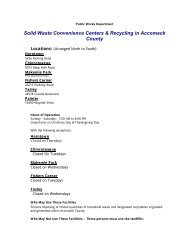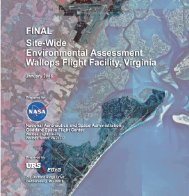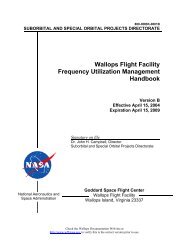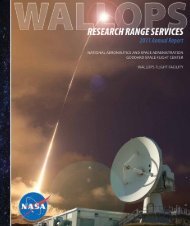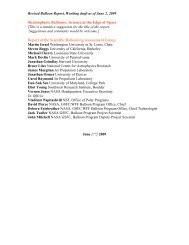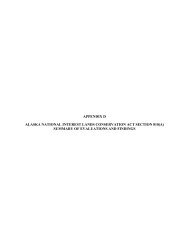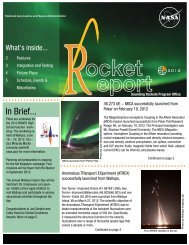Alternative Energy Draft EA - NASA Visitor Center at Wallops Flight ...
Alternative Energy Draft EA - NASA Visitor Center at Wallops Flight ...
Alternative Energy Draft EA - NASA Visitor Center at Wallops Flight ...
Create successful ePaper yourself
Turn your PDF publications into a flip-book with our unique Google optimized e-Paper software.
Affected Environment<br />
Over the entire study period, the majority of calls (55.2 percent) were identified as “unknown.”<br />
Of these unknown sequences, sequences likely to be eastern red b<strong>at</strong>s or eastern pipistrelles were<br />
most common (44.9 percent). The majority of call sequences could not be identified to guild or<br />
species, however, due to short call sequences (less than five pulses) or poor call sign<strong>at</strong>ure<br />
form<strong>at</strong>ion, which were often a result of b<strong>at</strong>s flying <strong>at</strong> the edge of the detection zone of the<br />
detector or flying away from the microphone.<br />
Of the calls th<strong>at</strong> were identified to species or guild, those of the RBEP guild were the most<br />
common (27.9 percent), followed by the species within the BBSH guild (15.7 percent), hoary b<strong>at</strong><br />
guild (0.8 percent), and Myotid guild (0.3 percent).<br />
Within the RBEP guild, eastern red b<strong>at</strong>s accounted for 25.2 percent of the 2,140 total sequences<br />
recorded <strong>at</strong> <strong>Wallops</strong> Island, followed by sequences just as likely belonging to red b<strong>at</strong>s or eastern<br />
pipistrelles (2.5 percent) and eastern pipistrelles (0.1 percent). Within the BBSH guild, sequences<br />
just as likely belonging to big brown or silver-haired b<strong>at</strong>s accounted for 10.8 percent of the total<br />
sequences recorded, followed by those of big brown (4.4 percent) and silver-haired b<strong>at</strong>s (0.5<br />
percent).<br />
Considering the level of b<strong>at</strong> activity documented <strong>at</strong> <strong>Wallops</strong> Island, numbers of recorded b<strong>at</strong> call<br />
sequences are not necessarily correl<strong>at</strong>ed with number of b<strong>at</strong>s in an area. Acoustic detectors do<br />
not allow for differenti<strong>at</strong>ion between a single b<strong>at</strong> making multiple passes and multiple b<strong>at</strong>s each<br />
recorded a single time. Similarly, acoustic interference can make detection of b<strong>at</strong>s in certain<br />
areas difficult, lowering the estim<strong>at</strong>e of acoustic activity.<br />
Furthermore, calls of some b<strong>at</strong>s, such as Rafinesque’s big-eared b<strong>at</strong>, are not as detectable as calls<br />
of other b<strong>at</strong>s, limiting the inferences th<strong>at</strong> can be made about the presence or absence of listed<br />
species. Rafinesque’s big-eared b<strong>at</strong> is the only special st<strong>at</strong>us species (St<strong>at</strong>e-endangered) likely to<br />
occur in the region of <strong>Wallops</strong> Island and surrounding counties (BCI, 2001). Although no call<br />
sequences likely belonging to Rafinesque’s big-eared b<strong>at</strong>s were detected, the b<strong>at</strong>’s distribution<br />
range overlaps <strong>Wallops</strong> Island, which may provide suitable habit<strong>at</strong> (VDGIF, 2009). However,<br />
roosting and foraging d<strong>at</strong>a for this species are lacking (BCI, 2001). The 2008 summer-fall b<strong>at</strong><br />
survey can neither confirm nor exclude the presence of Rafinesque’s big-eared b<strong>at</strong> in the study<br />
area.<br />
3.2.4 Thre<strong>at</strong>ened and Endangered Species<br />
Under Section 7 of the ESA, as amended, (U.S.C. 1531–1544) Federal agencies, in consult<strong>at</strong>ion<br />
with the USFWS and the N<strong>at</strong>ional Marine Fisheries Service (NMFS), are required to evalu<strong>at</strong>e the<br />
effects of their actions on special st<strong>at</strong>us species of fish, wildlife, and plants, and their habit<strong>at</strong>s,<br />
and to take steps to conserve and protect these species. Special st<strong>at</strong>us species are defined as<br />
plants or animals th<strong>at</strong> are candid<strong>at</strong>es for, proposed as, or listed as sensitive, thre<strong>at</strong>ened, or<br />
endangered by USFWS.<br />
The Virginia Endangered Species Act (29 VAC 29.1-563–570) is administered by the Virginia<br />
Department of Game and Inland Fisheries (VDGIF) and prohibits the taking, transport<strong>at</strong>ion,<br />
processing, sale, or offer for sale of any St<strong>at</strong>e or federally listed thre<strong>at</strong>ened or endangered<br />
species. As a Federal agency, <strong>NASA</strong> voluntarily complies with Virginia’s Endangered Species<br />
Act.<br />
66




